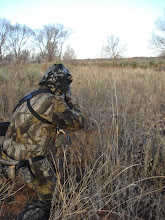I've read and heard many times that magnifying optics are slower and harder to use than iron sights or red dots. I do not agree.
If you have a quality optic that is set up on the rifle correctly to fit you then it is very, very fast and easy to use.
The keys are "quality optic" and "set up on the rifle correctly to fit". If either key is wrong then the system will be slow and difficult to use.
The quality part should be obvious. I won't get into a discussion of brands, but I recommend you avoid the $29 scopes from Walmart and lots of places online. They will probably not satisfy you. A midrange scope from any of the decent name brands will probably be fine. It may not work correctly after you drive a nail into a 4"x4" with it like some of the really high end optics claim, but that is sort of an extreme situation.
The scope has two critical parts to it's position:
1. How well your eye is centered in the scope i.e. too high or too low relative to the center axis of the scope.
2. Eye relief i.e. how far your eye has to be from the eyepiece lens to work correctly. Or, to put it another way, where the scope is mounted front to rear on the rifle.
For number 1, most of the problems are with mounting the rifle too high or too low. People typically mount their scope too high on bolt guns and lever guns. They use the really high "see-thru" rings and end up having a hard time consistantly getting a good cheek weld. OTOH I often see scopes mounted far too low on AR type rifles. I see lots of pics in gun magazines where some hunting writer is having his first go round with an EBR and he mounts the scope on the lowest rings he can find that will let the scope clear the handguard. The comb of the rifle ends up on his temple when he tries to sight through the scope.
Scope and scope ring manufacturers aggravate this problem by recommending ring heights based solely on the diameter of the objective lens without taking into account differences in stock shapes and rifle designs. Obviously a scope with a 50mm objective will have to be mounted higher than one with a 33mm objective, but if you do mount that big scope on a typical bolt action sporter then the center axis of the scope will be higher than the stock was designed for and you will probably have to add some height to the comb of the stock. Flat top AR type rifles seldom have trouble clearing a big objective lens because the stock is in a straight line with the bore. The scopes on these rifles have to be mounted up high for you to get a normal cheek weld. different shape gun, different mounting solution.
For number 2, the eye relief, I think many people mount their scopes too far to the rear. I've handled lot's of scoped rifles and I've never, ever had one with the scope mounted too far forward. I've had trouble more than once where the scope was as far forward as the normal mount would go and it was still too far back. Different mounts, like an extended Picatinny rail, or maybe extended rings are required in that case. Adding to the length of pull would theoretically solve the problem but most rifles already have a LOP that is too long.
How long should the LOP be? Easy test: Put the butt of your rifle in the crook of your elbow on your strong side, with your elbow bent. You should be able to reach the trigger with the first joint of your trigger finger without difficulty. Reaching the trigger with your second joint would be better. BTW do this with the normal clothes you wear when using the rifle. If you are going to be wearing a heavy coat then perform the test with the same heavy coat on. I recommned you deal witht he LOP issue before you mess with your scope.
The "set up on the rifle correctly to fit" is fairly easy to test, but not always easy to achieve.
Here is your basic test to see if you have your scope set up properly for YOU on YOUR rifle. I will assume that you have a place where you can safely handle and mount your rifle without getting a visit from your local LEOs. No ammo is needed for this, but you may want to try this with and without your normal ear and eye protection and hat, just to see if there are any issues with your gear.
1. Always follow the Four Rules.
2. Pick a "target". This can be any reasonable sized, fixed object. I like one at least 25 yards away. It should not be something tiny. Something about a foot across is a good size at 25 yards. A boulder or a tree stump will work. If you are at a shooting range then the target holder will probably be about right.
3. Stand with your rifle at low ready and face the target as if you were going to shoot at it. Normally your "strong" side will be angled back away from the target a little and your "weak" side foot will be a little ahead of your "strong" side foot.
4. Close your eyes. Keep them closed.
5. Mount your rifle as if you were going to shoot at your target.
6. Open your eyes and look at what you see in the eyepiece lens of the scope. Don't adjust anything, just look.
Do you see the full field of view? Are you looking through the center of the scope?
If you have to make ANY adjustments then the scope/rifle system is not set up correctly for you.
If you have to make any adjustments then note how you have to move to get the full field of view. The scope will have to go the opposite direction to compensate. How much? I don't have a good answer for that. I have a box of old scope rings in different heights that I've picked up over the years so I have samples in different heights. If you don't have that then you may end up buying a couple of inexpensive sets of rings just to get the actual height you need when you buy your good rings.
A couple of other thoughts on this.
Variable power scopes can be a problem. The eye relief and the eye relief range changes as the magnification changes. For example, if you have a 2x to 7x scope, the eye relief on 2x might run from 3 to 5 inches, while on 7x it might run 2 to 3.5 inches. There range changes and the whole range moves. I just made up those numbers, but you get the idea. You will need to run this test at the high end and low end. If it works at both extremes it will probably work in the middle.
Your face ends up in a different spot on the rifle when you shoot from different positions. After you make your first adjustments and are satisfied with how things work when offhand, then try it again from braced kneeling, cross-leg sitting, open-leg sitting, squatiing, prone, and from improvised field rests. You may end up having to make more changes to the setup.
Combining the variable power scope with different field positions will make for a lot of test runs. You may find that you don't have enough eye relief range on the scope or mounts/rings. After playing around with this you will probably look at the eye relief numbers on scopes a little closer. I've found that it is often difficult to get the eye relief numbers on variable power scopes. Manufacturers often just publish the max eye relief number from the lowest magnification and the minimum eye relief number from the highest power setting. You won't get the full range on the highest magnification setting, I can tell you that.
Fixing scope mounting issues may cost you some time and money, but the results will be worth it.
Letting the Music Out
8 hours ago


7 comments:
Thank you for this info Bitmap. I am going to be sighting in my scope this weekend and this is just what I needed. I have a cheap scope though but it seems to be fair. Again, thanks for the info., very good stuff from someone I trust on this subject.
Bullseye
Code Name "Bullseye"
If I ever live somewhere with a field of fire in excess of 100 yards I'll probably get myself a good scope, so be sure and leave this in your archives. No telling when I'll need it down the road.
Hermit, my average distance for both mule deer and whitetails is right at 50 yards. One shot at 50 yards would have been impossible without optics (in that case a 2.5x IER scope) and one just over 100 yards would have been extremely difficult (again with a 2.5 IER scope) because of near darkness.
The shot at 50 yards was a mule deer in heavy brush. I had seen him in the edge of the brush as he was moving deeper into it. I could see him with binos and the scope but not with the naked eye. He was completely invisible without optics. With optical assistance I put him in the freezer.
I'll post about IER scopes in the near future.
Interesting info. I do not think anything beats a CCO (aimpoint red dot) for sheer speed of acquisition though some folks with EOTechs will probably disagree.
For those who need a magnified optic this info is great. I will keep it in mind when I next scope a rifle. Swapped out my old scoped rifle but kept the Leupold 3x9. Don't want to drill into my Springfield or the Garand. Got to get a Remington 700 or something.
Thanks for coming by TOR.
Red dots that are parallax free are about the fastest. The Aimpoint CompM series is parallax free and very fast. The Eotech is also parallax free. Some red dot's are not parallax free and they require the same care in aligning your eye with the center of the tube than magnifying optics require.
Most people find that parallax free red dots are faster when they are mounted farther forward. I know I do. I like to have it out and away from my face.
I have that IER scope article saved as a draft but it needs work and pics.
Haven't hunted in a number of years now, but in my day I had upward to 30 long guns. The one I used for most of my deer hunting was a browning 270 cal with a 4x Redfield widefield. I like that scope so well that I put the same model scope on about 5 rifles I had. My favorate varmit rifle was a bolt action Remington .17 cal, and my squirrel rifle was a Remington 5mm---now that was an accurate rimfire. When I could I used a low mount, but can see the advantage sometimes in using a high mount. Great detailed post.
Post a Comment